Summer of 1947
Reunion with Hiroshima
In August 1947, Shunkichi Kikuchi visited Hiroshima again as a member of the "LIVING HIROSHIMA" photo collection production staff.
That year, to attract tourists from overseas, the Hiroshima Tourist Association Press planned to publish an English-version photo collection that would show how Hiroshima was recovering from the bombing catastrophe, as well as picturesque places in the prefecture. Tsuguzo Tanaka, business representative of Seto Inland Sea Library (Setonaikai Bunko), which was commissioned by the Hiroshima Tourist Association Press to publish the collection, poured extraordinary enthusiasm into this project, determined to complete a superior product without regard to profit. To produce the project, he selected Bunka-sha, which was making a fresh start with members from the former Toho-sha, including Kikuchi.
After overcoming censorship, insufficient funding and other difficulties, "LIVING HIROSHIMA" was published in May 1949, starting with the following sentence: "Hiroshima is still alive."
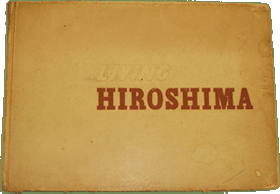 |
"LIVING HIROSHIMA" |
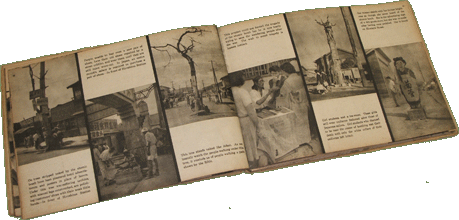 |
|
Recovery of the City and People's Lives
When Kikuchi visited Hiroshima again in 1947, the city was proceeding with rubble removal, grading, and other land improvements. Its decimated population had recovered to 212,000 people, more than sixty percent of its population prior to the bombing. Housing construction was also proceeding, but much of it consisted of temporary or makeshift housing that would not withstand long-term usage. Shortages of food and basic necessities persisted, and people continued to live austere lives. Dabbling in the black-market and cultivating fields without permission in the charred rubble were unavoidable means of survival.
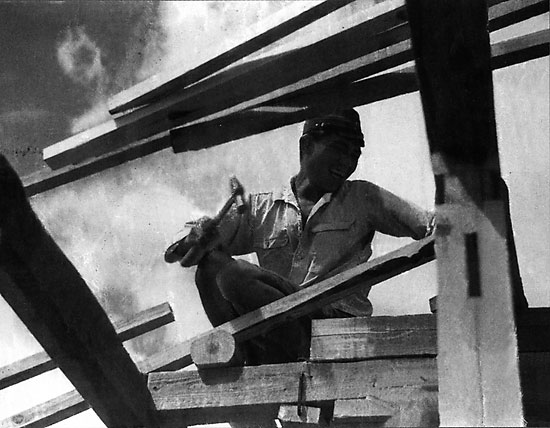 Construction of houses and buildings Location: Ebisu-cho Construction using new building materials had also begun. This photograph was taken near the Ebisu Shrine on Kinzagai Street. Kikuchi's camera captured the cheerful expressions of people working with tools. |
| Row of simple frame houses Location: Moto-machi Simple frame houses frame built on the former site of the Hiroshima First Army Hospital. Each house had an area of approximately 250 square feet (7 tsubo). Because their construction was of a temporary nature, they deteriorated quickly as well. | 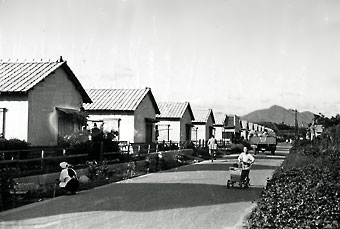 |
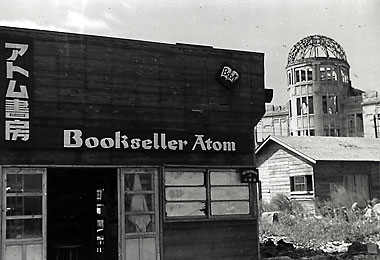 Bookstore in Sarugaku-cho Location: Sarugaku-cho (now, Ote-machi 1-chome) Immediately after the bombing, all of the buildings in the entire Sarugaku-cho area, which included A-bomb Dome, had collapsed and were engulfed in flames. There were no survivors. Two years later, in areas where rubble remained, private houses were being built and a bookstore named "Atom" had opened. |
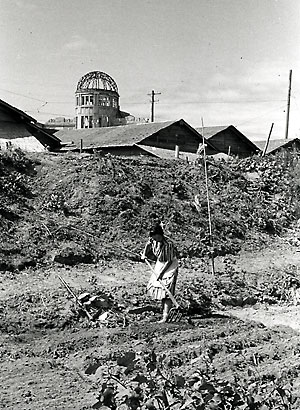 Field on former site of Western Drill Ground Location: Moto-machi As food shortages continued, people looked for empty land on which to cultivate, and they planted crops such as squash and potatoes. This woman cultivated a field on the former site of the Western Drill Ground. In the foreground, an eggplant crop is bearing fruit. |
|||
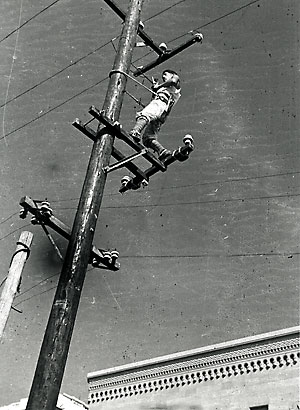 Re-erection of utility pole Location: Kamiya-cho Re-erection of a utility pole along the streetcar-line avenue in front of the Geibi Bank head office. Restoration work immediately after the bombing was temporary in nature, and fuel shortages resulted in the overuse of electric heaters. For reasons such as these, power outages occurred in succession. Thus, utility poles were being re-erected as needed. Electricity service had to be cut off with the erection of each new pole. |
 |
|||
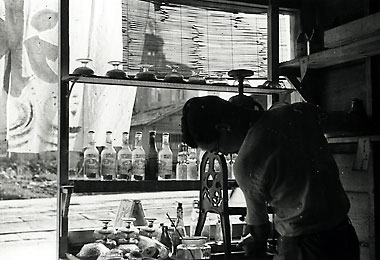 Shaved-ice shop on Aioidori Avenue Location: Moto-machi In front of the current Hiroshima Municipal Baseball Stadium, small makeshift (barrack-type) shops lined up along the streetcar-line avenue. One of those shops sold shaved ice. A-bomb Dome was visible through the rattan blinds. |
||||
